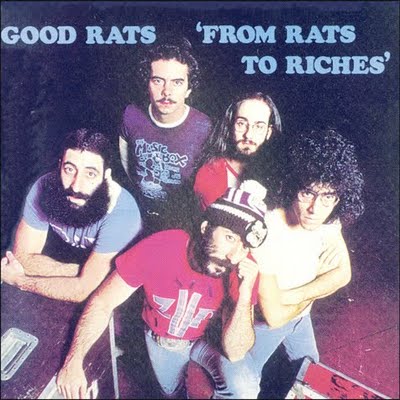| Columns Retired Columns & Blogs |
The Good Rats Discography
The Good Rats on Record

Although the five albums from the the original Good Rats are available from the band's website on CD on the Uncle Rat label, it's worth seeking out the original vinyl.
I'd bypass the rare The Good Rats album on Kapp records from 1969 (which was rereleased on CD in the '90s on a German label) as this is early Marchello. It's a different band, a commercial rock album manipulated by two very strong producers, and shows Marchello before he developed as a strong writer. For historical purposes only.
Start right in with the first album, 1974'sTasty (Warner Brothers BS 2813), which I'd put, musically and sonically, on my list of the top 20 rock albums of all time. In addition to the aforementioned "Songwriter" and "Klash Kabob," the album features two jazzy tunes, the title track and "Fred Upstairs and Ginger Snappers." Remember this album was recorded when Warner Brothers was at their peak sonically within the rock genre. (Think Grateful Dead's American Beauty). One caveat, however. Warner Brothers dropped The Good Rats soon after this album's release, and when Marchello regained the rights to reissue the album, he did so on his own Rat City Records. However, the engineer remixed the album using excessive digital processing, EQ and the Aphex Aural Exciter so it has none of the naturalness of the Warner Brothers pressing. Avoid the reissue.
1976's Rat City In Blue (Rat City RCR-8001) is nearly as good as Tasty and features most of the most of the music the band toured with during the Tasty period. The basic hard rock of "Does It Make You Feel Good" shares space with the maniacal guitar showcase instrumental title track and the poignant power ballad, "The Room." Sound is not quite as natural as the original Warner Brothers Tasty but is superior to the Rat City reissue of that first album.
The Good Rats secured a contract with Arista/Passport in 1978 and From Rats To Riches (Arista/Passport PB 9825) was the result. I call this the band's "second" period, with material nearly as strong as the earlier work. The album includes the opening tune of all Good Rats reunion concerts, the hard rocking "Takin' It To Detroit" and the Good Rats audience participation tune, "Local Zero" where Marchello throws rubber rats from a garbage can out into the audience (I have four in my collection). The band's next Arista/Passport album, 1979's Birth Comes To Us All was a major departure for The Good Rats. This album marks the first time that a major label put marketing muscle behind the band. The album is much more commercial than previous efforts with the addition of studio musicians to the recording. (Guitarist John Tropea does a very tasteful solo towards the end of an older Rats tune, "City Liners.") The tour for this album included an added keyboardist and horn section and focused on larger arenas (I saw them open for Rush and Styx at New York's Nassau Coliseum. But the music is first rate.
Not so for the last Good Rats album, Great American Music (LP, Great American GAR 8003). The music here is not bad but doesn't compare to the tunes on the previous four releases. Also, the original band members began to bail on Peppi at the this point. Bassist Lenny Kotke was replaced by the competent Schuyler Deale, but the pedestrian and formulaic lead guitarist Bruce Kulick cannot approach the virtuosity and tastefulness of the departed John Gatto. By the time the Good Rats broke up in 1983, Kulick had replaced Ace Frehley in Kiss and Peppi was the only original member of the band remaining.
- Log in or register to post comments




































